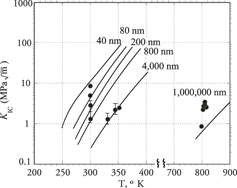Crossref Citations
This article has been cited by the following publications. This list is generated based on data provided by
Crossref.
Fang, Qihong
and
Zhang, Liangchi
2013.
Emission of partial dislocations in silicon under nanoindentation.
Journal of Materials Research,
Vol. 28,
Issue. 15,
p.
1995.
Hintsala, Eric
Teresi, Claire
Wagner, Andrew J.
Mkhoyan, K. Andre
and
Gerberich, William
2014.
Fracture transitions in iron: Strain rate and environmental effects.
Journal of Materials Research,
Vol. 29,
Issue. 14,
p.
1513.
Kiani, Sara
Yang, Jenn‐Ming
Kodambaka, Suneel
and
Green, D. J.
2015.
Nanomechanics of Refractory Transition‐Metal Carbides: A Path to Discovering Plasticity in Hard Ceramics.
Journal of the American Ceramic Society,
Vol. 98,
Issue. 8,
p.
2313.
Mueller, M.G.
Pejchal, V.
Žagar, G.
Singh, A.
Cantoni, M.
and
Mortensen, A.
2015.
Fracture toughness testing of nanocrystalline alumina and fused quartz using chevron-notched microbeams.
Acta Materialia,
Vol. 86,
Issue. ,
p.
385.
Jaya, Balila Nagamani
Kirchlechner, Christoph
and
Dehm, Gerhard
2015.
Can microscale fracture tests provide reliable fracture toughness values? A case study in silicon.
Journal of Materials Research,
Vol. 30,
Issue. 5,
p.
686.
Norton, A.D.
Falco, S.
Young, N.
Severs, J.
and
Todd, R.I.
2015.
Microcantilever investigation of fracture toughness and subcritical crack growth on the scale of the microstructure in Al 2 O 3.
Journal of the European Ceramic Society,
Vol. 35,
Issue. 16,
p.
4521.
He, Yang
Zhong, Li
Fan, Feifei
Wang, Chongmin
Zhu, Ting
and
Mao, Scott X.
2016.
In situ observation of shear-driven amorphization in silicon crystals.
Nature Nanotechnology,
Vol. 11,
Issue. 10,
p.
866.
Hintsala, ERIC
Teresi, CLAIRE
and
Gerberich, WILLIAM W.
2016.
Linking Nanoscales and Dislocation Shielding to the Ductile–Brittle Transition of Silicon.
Metallurgical and Materials Transactions A,
Vol. 47,
Issue. 12,
p.
5839.
Jaya, B. Nagamani
and
Jayaram, Vikram
2016.
Fracture Testing at Small-Length Scales: From Plasticity in Si to Brittleness in Pt.
JOM,
Vol. 68,
Issue. 1,
p.
94.
Pizzagalli, L.
2016.
Atomistic modeling of the dissociation of a screw dislocation in silicon.
Journal of Materials Science,
Vol. 51,
Issue. 6,
p.
2869.
Jaya, Balila Nagamani
Wheeler, Jeffrey M.
Wehrs, Juri
Best, James P.
Soler, Rafael
Michler, Johann
Kirchlechner, Christoph
and
Dehm, Gerhard
2016.
Microscale Fracture Behavior of Single Crystal Silicon Beams at Elevated Temperatures.
Nano Letters,
Vol. 16,
Issue. 12,
p.
7597.
Mueller, Martin Guillermo
Žagar, Goran
and
Mortensen, Andreas
2017.
Stable room-temperature micron-scale crack growth in single-crystalline silicon.
Journal of Materials Research,
Vol. 32,
Issue. 19,
p.
3617.
Huang, Kai
Sumigawa, Takashi
Guo, Licheng
Yan, Yabin
and
Kitamura, Takayuki
2018.
Unstable cracking behavior in nanoscale single crystal silicon: Initiation, unstable propagation and arrest.
Engineering Fracture Mechanics,
Vol. 196,
Issue. ,
p.
113.
Teresi, Claire S.
and
Gerberich, William W.
2018.
Silicon activation volumes for fracture as affected by hydrogen.
Scripta Materialia,
Vol. 144,
Issue. ,
p.
56.
Pizzagalli, L.
Godet, J.
and
Brochard, S.
2018.
Influence of strain on dislocation core in silicon.
Philosophical Magazine,
Vol. 98,
Issue. 13,
p.
1151.
Ast, J.
Schwiedrzik, J.J.
Wehrs, J.
Frey, D.
Polyakov, M.N.
Michler, J.
and
Maeder, X.
2018.
The brittle-ductile transition of tungsten single crystals at the micro-scale.
Materials & Design,
Vol. 152,
Issue. ,
p.
168.
Vincent, L
Djomani, D
Fakfakh, M
Renard, C
Belier, B
Bouchier, D
and
Patriarche, G
2018.
Shear-driven phase transformation in silicon nanowires.
Nanotechnology,
Vol. 29,
Issue. 12,
p.
125601.
Kilymis, D.
Gérard, C.
Amodeo, J.
Waghmare, U.V.
and
Pizzagalli, L.
2018.
Uniaxial compression of silicon nanoparticles: An atomistic study on the shape and size effects.
Acta Materialia,
Vol. 158,
Issue. ,
p.
155.
Zhang, Zhenyu
Cui, Junfeng
Chang, Keke
Liu, Dongdong
Chen, Guoxin
Jiang, Nan
and
Guo, Dongming
2019.
Deformation induced new pathways in silicon.
Nanoscale,
Vol. 11,
Issue. 20,
p.
9862.
Cheng, Guangming
Zhang, Yin
Chang, Tzu-Hsuan
Liu, Qunfeng
Chen, Lin
Lu, Wei D.
Zhu, Ting
and
Zhu, Yong
2019.
In Situ Nano-thermomechanical Experiment Reveals Brittle to Ductile Transition in Silicon Nanowires.
Nano Letters,
Vol. 19,
Issue. 8,
p.
5327.





